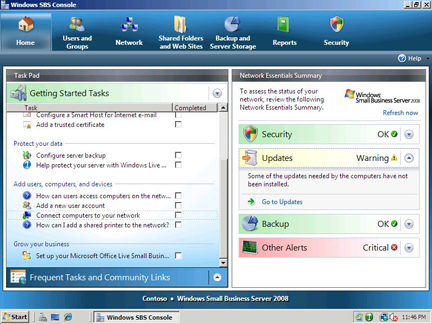Windows Small Business Server 2008: a first look

The latest small-business implementation of Windows Server, Windows Small Business Server 2008 (SBS 2008), is now available for public testing, with an official release date of 12 November. However, customers expecting the usual revamp of the old Windows and Exchange Server bundle are in for a shock, as there are big changes in both the content and the packaging of the new small-business product.
Superficially it looks like the standard Microsoft makeover. As with previous versions, SBS 2008 is aimed at companies with up to 75 users and comes with the popular Exchange Server messaging product as standard. It also majors on ease of use, with custom tools to simplify both installation and day-to-day management tasks. Unlike previous releases, however, SBS 2008 can only run on 64-bit hardware — principally because of the inclusion of the latest Exchange Server 2007 product, which is 64-bit only.
The 64-bit requirement shouldn't deter new buyers as it's almost impossible to buy a 32-bit server these days, but companies wanting to upgrade will need to replace their hardware first. Minimum requirements are a single- or multi-core x64 processor plus 4GB of memory and at least 60GB of free disk space. In-place upgrades aren't an option — at least not in the release candidate: only migrations of users, settings and data from an existing server to a new SBS 2008 setup are supported.
As before, two editions — Standard and Premium — will be available, both designed to run on a single host system deployed as an Active Directory domain controller. A full implementation of Exchange Server 2007 is included in both versions, along with SharePoint Services 3.0 collaboration and productivity software. However, there are big changes for Premium buyers, who get the latest SQL Server 2008 product (also being released on November 12th) together with a second copy of Windows Server 2008 so that a separate database server can be configured
A first for the SBS package, the additional server can be either 32-bit or 64-bit, with a copy of SQL Server 2005 also included to run applications that are not certified for the 2008 platform. Also, the second server can be configured to host shared applications running under the extended multi-user terminal services also available in Windows Server 2008.
Another big change is the ditching of Windows ISA (Internet Security and Acceleration) Server, previously included in the Premium bundle to handle internet connectivity and security. Instead, customers are expected to deploy SBS 2008 behind an independent internet router/firewall and make use of the security features available in the latest Windows Server platform to protect their network.
Again, this looks like a sensible move, and is unlikely to deter new buyers. However, it could be an issue for upgraders who are already running with ISA protection.

Windows Small Business Server 2008 delivers secure access to business contacts, calendars, email, files and other desktop resources from any internet-connected computer.
A single administrative console provides a convenient view of PCs and servers, making it straightforward to manage common IT tasks.
There are lots of built-in tools to monitor server health and security in SBS 2008, but the main focus is on email protection: a 120-day evaluation copy of Forefront Security for Exchange Server is included to scan messages for viruses, spam, spyware and so on. Also bundled is a 120-day trial licence for Windows Live OneCare, this online service providing more general server protection against internet threats. Microsoft is also keen to highlight integration with the free Windows Server Update Services (WSUS) and the network access protection facilities provided by Windows Server 2008 to prevent poorly configured clients from connecting to the network.
Other changes include a further simplifying of the SBS management console plus a move towards taking backups to hard disk rather than tape in this release. Integration with the Office Live Small Business services is yet another new feature, along with changes to the way clients are licensed to suit the new software bundle.
Beyond the small business
Whether or not SBS 2008 users will be able to take advantage of the command line Server Core and Hyper-V virtualisation facilities provided as part of the Windows Server 2008 platform isn't clear. However, an implementation for larger companies called Windows Essential Business Server is also due for release on 12 November, and this will leverage the virtualisation options. Look out for full reviews of both this and the SBS 2008 product in the run-up to what's shaping up to be a busy November for Microsoft.